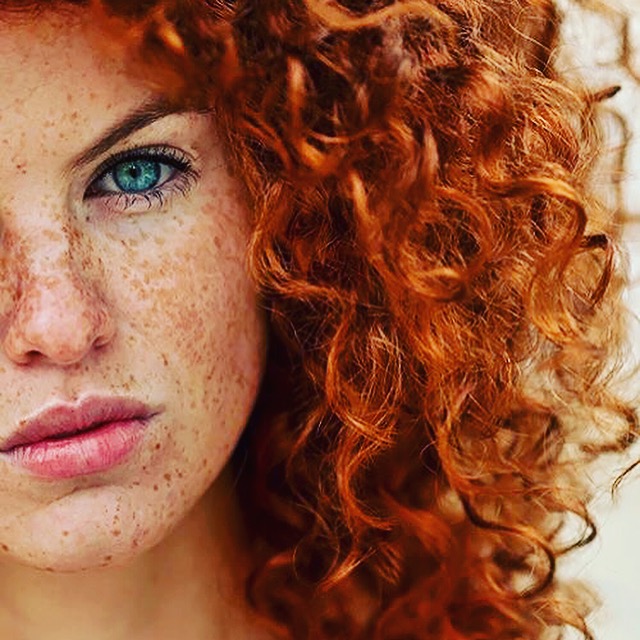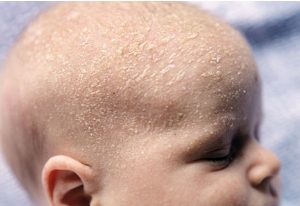Hair Science, Our Hair
CRADLE CAP
Cradle cap most commonly occurs in the first three months of a baby’s life. It can be easily treated, and your child is likely to be unaware of the condition.
The exact cause of cradle cap is unclear, but a theory is that remains of the mother’s hormones from the pregnancy stay in the baby’s body for a few months, causing an increase in the rate of sebum (oil) production in some babies. Sebum is a waxy/oily substance produced by the sebaceous glands, at least one located next to every hair follicle, which serves to lubricate the skin, and also the hair as it emerges from the scalp. The dead skin cells on the surface of the scalp, which would normally fall away unnoticed, become stuck together by this excess sebum, resulting in the distinctive large, yellowy scales of cradle cap. Whilst the condition is harmless, and usually goes away within a few months, it can be unsightly, and in a small percentage of cases, become infected. It is therefore a good idea to try and remove the scales.
The simplest way to remove the scales of cradle cap is by applying a little baby oil that has first been warmed in the hands. This will help to loosen and soften the scales, which can be quite solid. A toothbrush can then be used to gently lift the scale away from the scalp, with small circular motions, or you can gently scratch and remove with your finger nails (please ensure your hands are clean). Ideally the babyoil will provide enough lubrication to allow the scales to slide off of the hair, but if some hair does come away, please be reassured that this will grow back, and there will be no permanent hair loss. After removing the scales in this way, it is best to shampoo the baby’s hair, gently washing out the oil, along with any remaining flakes. Cradle cap cannot be prevented from occurring, but the degree of severity may be minimised by shampooing your baby’s hair regularly with an appropriate shampoo, which will prevent the dead skin cells from being able to build up too much. Most parents give their baby a daily bath, in which case a daily hair wash can become part of the routine, but if you prefer not to give them a full bath every day, and your baby seems to be suffering from cradle cap, you can always just wash their hair. Most cases of cradle cap clear up within six months, and a baby affected by the condition is no more likely to suffer from a scalp condition in later life than a baby who is unaffected. HOW TO SHAMPOO YOUR BABY’S HAIR A newborn baby’s scalp isn’t fully formed. At the top of their head (the crown) the skull bones haven’t completely come together. This means that there is a soft spot or indentation (fontanelle). Many mothers are afraid to wash their babies’ hair for fear of injury, but your baby’s scalp should be washed along with the rest of their body. In the first 4 weeks, simply rinsing your baby’s hair with warm water is fine. However, as your baby gets older, and their hair begins to grow, a little shampoo will help to cleanse more effectively. Wet your baby’s hair thoroughly and carefully. A good idea is to use a jug/ bowl as the noise and speed of a shower can be quite scary. Pour a little shampoo between your hands and smooth over your baby’s hair and scalp. Lather the shampoo with a very gentle motion, taking care around the soft area at the front. Always support your baby, leaning them back to avoid shampoo getting in their eyes. Rinse with fresh water from the tap, rather than bath water, to ensure a thorough clean. Baby towels often have a hood attached that can be used to gently blot your baby’s hair. Don’t rub – a baby’s hair is fine and prone to damage. Also, refrain from drying the hair, as babies’ skin is more sensitive than an adult’s and can be easily burnt. The hair will dry quickly on its own. HOW OFTEN TO WASH YOUR BABY’S HAIR It is safe to shampoo your baby’s hair every day as long as you use a mild shampoo. Daily washing also helps to discourage the formation of cradle cap. CONDITIONING YOUR BABIES’ HAIR It’s not necessary to condition your baby’s hair when it’s relatively fine and fluffy. But once their hair starts to grow longer and thicker, apply a little conditioner to help keep it in its best condition.




